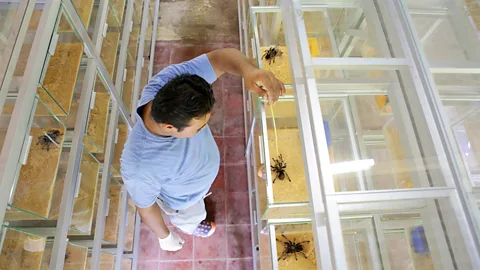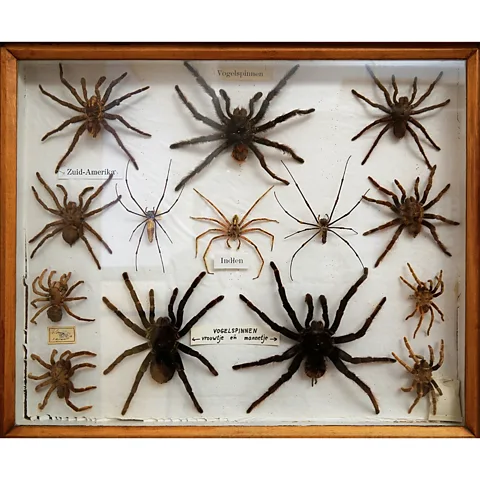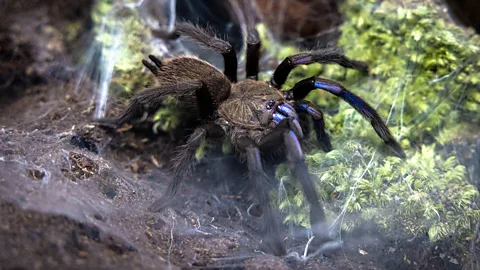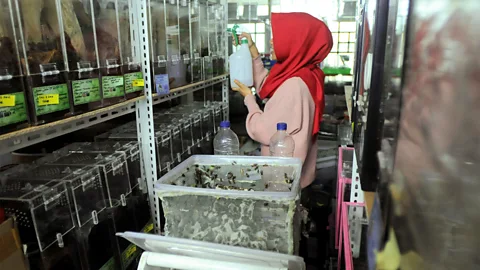'People collect spiders like Pokemon': Why the illegal tarantula trade is booming
 Getty Images
Getty ImagesThe global arachnid trade is threatening the world's most famous spider species. And it's primarily driven by souvenir collectors.
With their eight beady eyes and furry limbs boasting retractable claws, tarantulas are polarising creatures. During Jackie Peeler's more than 40-year career managing creepy crawlies in zoos and museums, she's seen people love and fear them in equal measure. About 25 years ago, she used to run a mobile zoo programme where she would shuttle tarantulas around to places like outdoor festivals and malls. She'd take them out of their carriers and show them off to captivated crowds who'd exclaim over their furry legs and cartoon-like expressions.
"There is a powerful connection when people can see something they may never see in the wild," says Peeler, now manager of the animal care centre at the Boston Museum of Science. "Invertebrates and insects can be one of those things that people, even when they're terrified, are still fascinated by."
Peeler doesn't condone showing off tarantulas in such a way anymore – they should have agency to hide from crowds if they want to – but even when they're not front and centre, these unusual creatures command attention. With that magnetism comes a dark undertow; enthusiasts are driving the illegal trade of tarantulas worldwide.
"Tarantulas are charismatic organisms," says Chris Hamilton, an assistant professor in the department of entomology, plant pathology and nematology at the University of Idaho. "That's what's great about them because we can use them to educate the public."
Hamilton believes the "tarantula hobby" started gathering steam in the 2000s. Today, researchers regularly see enthusiasts boasting collections of more than 100 species in online forums. "[These] forums show that people collect spiders a bit like people collect Pokemon – they want to 'catch 'em all'," says Alice Hughes, associate professor of biology at the University of Hong Kong. It's a spot-on analogy, considering how many different colours and patterns tarantulas can assume.
 Getty Images
Getty ImagesUnsurprisingly, the tarantula trade has become a small but prevalent staple of the multi-billion-dollar illegal wildlife trade industry. And it is not just unlawful – experts believe, along with climate change and habitat destruction, tarantula poaching could threaten some species to the point of extinction before scientists get a chance to study them.
"Tarantulas are especially vulnerable to poaching because they're long-lived – some reach 30 years old – and females reproduce late and infrequently," says Hamilton. "This is terrible for withstanding human disturbance (habitat destruction, pet trade collecting, or climate change) because of how long it takes to regenerate populations." He stresses that several range-restricted tarantula species (endemic to certain areas) – such as some in the genus Poecilotheria, native to India and Sri Lanka – are also "highly susceptible to extinction".
Keeping tarantulas as pets, however, doesn't seem to be what's currently driving the trade market. Some 43% of tarantula species are traded as souvenirs (for mounting and framing post-mortem), as research tools, and for medicine, according to a study. The souvenir market seems to be growing the fastest.
Wildlife poaching grew exponentially in the 1970s and 80s; around the same time, keeping tarantulas as pets became popular. As demand escalated, so did captive breeding and the legal trade market. However, Peeler believes the illegal tarantula market grew faster since doing everything above board takes time and money and involves acquiring permits. And it skyrocketed with the advent of the internet; suddenly, it was much easier for traders and tarantula fans to find each other.
There are seemingly endless ways to transport the small invertebrates, making regulating the trade market a complex and potentially untenable endeavour. In 2010, a German man sent hundreds of baby tarantulas packaged in multi-coloured straws via the US Postal Service. In December 2021, Colombian authorities at El Dorado Airport detained two people attempting to smuggle more than 230 tarantulas to Europe in one suitcase. In November 2024, a man was caught trying to smuggle hundreds of tarantulas out of Peru by strapping them to his body. Airport staff noticed the man's stomach looked an usual shape and found the animals in ziplock bags attached to two girdles around his body. It is thought he had been trying to take them out of the country to South Korea.
Hughes says the other reason tarantula trade regulation is challenging is the lack of existing data (ecology, distribution and population trends) on the animals. This also makes it difficult to assess the full impact of the illegal trade on species. There are at least 1,000 known species of tarantula in the world today, and many others have either yet to be catalogued or have been catalogued incorrectly by traders.
More like this:
• Are Halloween pumpkins a future superfood?
Only species listed under Cites (Convention on International Trade in Endangered Species of Wild Fauna and Flora) are tracked, "but these represent just a very small fraction of the tarantula species in trade," says Carol Fukushima, a tarantula taxonomist and researcher with Bisons Lab at the University of Turku in Finland. "Many are sold and transported without permits or records through methods like 'brownboxing', where specimens are shipped illegally, mislabelled or transported as non-wildlife to avoid detection," she says.
Fukushima says there are also likely discrepancies in species naming and identification within the illegal marketplace, further muddying the real impact of the trade. "See the case of Chilobrachys natanicharum, traded for years as 'Electric Blue Tarantula' but only scientifically described in 2023," she explains.
 Getty Images
Getty ImagesScientists need more funding to improve species cataloging and monitoring, but that's proven difficult to come by, Fukushima says she believes it may also be related to people's perceptions of spiders.
"It is known that the popularity of a species plays a significant role in attracting funding and supporting research and conservation," says Fukushima. "Unfortunately, arachnids and other invertebrates are typically not seen as charismatic or important by the general public. There is a widespread negative perception of arachnids, fuelled by arachnophobia and a lack of awareness about the crucial ecosystem services they provide, which benefit both the planet and humanity." Like most arachnids, tarantulas excel at controlling insect populations while also acting as a food source for larger species.
Media framing perpetuates these misconceptions and sensationalism surrounding spiders in general, research shows. "Too frequently – 41% [of the time] according to the report we analysed – the media portrays spiders negatively and includes numerous errors regarding their biology, ecology, and behaviour," says Veronica Nanni, the report's co-author and an ecologist focused on mass media, communication, and conservation.
Fukushima stresses that lack of funding for tarantula research, coupled with misinformed media attention perpetuating incorrect, negative stereotypes, makes it much more likely that tarantulas will be overexploited in a largely under-regulated arachnid trade.
Experts agree that bolstering tarantula trade regulations would be a step forward in conserving and protecting tarantula species, but it's an uphill battle. Of the over 1,000 species of tarantulas that exist, only about 3% are currently listed as protected on Cites (meaning they're actively monitored). The lack of official data on these arachnids makes it impossible to determine their vulnerability and develop corresponding conservation parameters.
 Getty Images
Getty ImagesSome countries are cracking down on the tarantula trade, including tarantula hot spots Brazil, Costa Rica, Peru and India, says Hamilton. "Countries like South Africa are particularly wary of spider trade, as many of these species could naturalise and become invasive," says Hughes. However, considering their small size and how unregulated wildlife trading online has become, Peeler doesn't think worldwide regulation is on the cards.
"The United States has some pretty strong rules in place. But they're not going to catch everything that comes across the border," says Peeler. "As long as there's a market, we'll always have illegal trade."
There is a silver lining to the unregulated tarantula trade; some experts believe it could indirectly help bolster some populations due to captive breeding. In fact, captive breeding might even help it become better regulated.
"[The tarantula trade] should be regulated by working with researchers and pet trade people to establish genetic reservoirs that can be maintained for the future – if any of these become highly threatened, or even go extinct in the wild," says Hamilton.
Hughes agrees that captive breeding can be a useful conservation tool as long as it's properly monitored. "A parallel is the EU wildbird directive, which has dramatically reduced the import of wild birds into the EU, and largely replaced this industry with one dominated by captive breeding," she explains. "Such an approach largely removes pressures on source populations and dramatically reduces the probability of transporting diseases and pathogens."
 Getty Images
Getty ImagesHowever, captive breeding is not a panacea for the illegal trade problem. Fukushima says improperly regulated and monitored captive breeding could indirectly stoke illegal and unsustainable trade. For captive breeding to be a genuinely successful conservation tool, a legitimate monitoring and tracking system needs to be in place at the start, and even then, it's not a perfect solution.
"Mexico has created successful legal captive breeding programmes with tarantulas. However, some Mexican breeders say that even these efforts may not be enough to produce specimens of Mexican tarantulas to meet market demand," says Fukushima.
She points to the implementation of a regulation comparable to the US Lacey Act, which prohibits the importation of specimens that violate the laws of their country of origin, in regions like the European Union as one possible way to bolster protections for neglected species like tarantulas.
We have a long way to go to properly safeguard tarantulas the world over, but experts agree the journey begins with educating the public on what fascinating creatures they are and why they deserve respect. The hope is this will lead to behavioural changes among collectors, encouraging them to choose more responsible, sustainable methods for procuring tarantulas.
If you're one of many people who get creeped out by spiders, Peeler's seen first-hand how quickly that can change given the right learning environment. One standout example happened at the Boston Museum of Science, where she met a little boy who was terrified of spiders but curious about one named Emily sitting outside her burrow.
"I asked him why he was scared, and he [went] on about how they're so foreign to him. [So] we talked for five or 10 minutes about how important spiders are, how many different types of spiders there are, and where they all live in the world. We talked about why tarantulas had hairs on their body and what made them different. And he was absolutely amazed," she says.
The little boy returned to the museum several times to check in on Emily and make sure she was eating well.
* This article was originally published on 30 October 2024 but was updated on 15 November 2024 to include details about an attempt to smuggle tarantulas out of Peru.
--
For essential climate news and hopeful developments to your inbox, sign up to the Future Earth newsletter, while The Essential List delivers a handpicked selection of features and insights twice a week.
